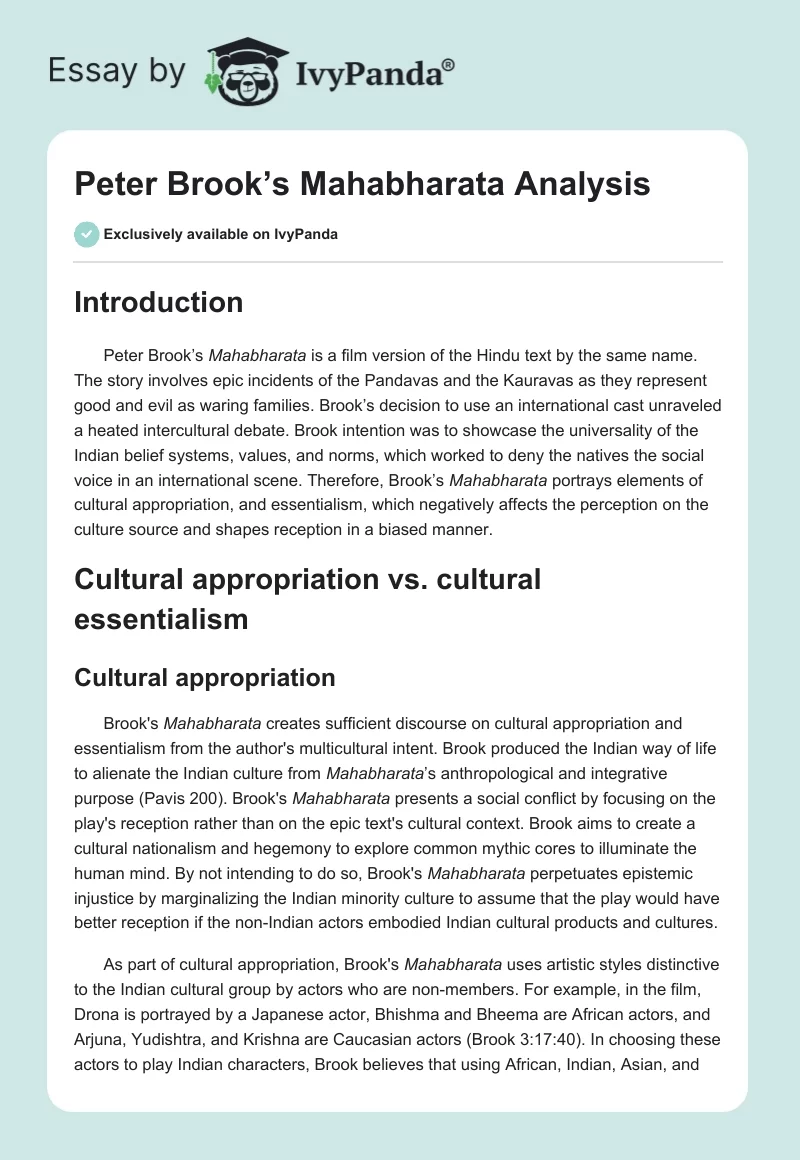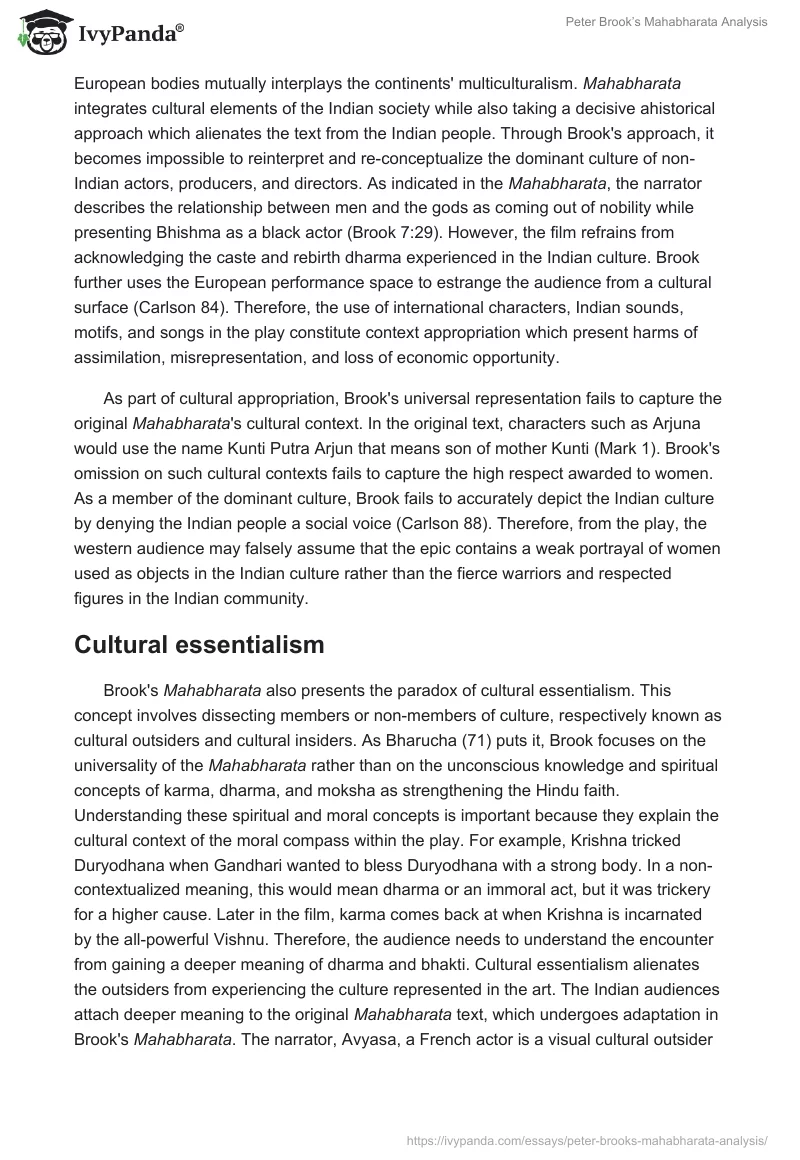Introduction
Peter Brook’s Mahabharata is a film version of the Hindu text by the same name. The story involves epic incidents of the Pandavas and the Kauravas as they represent good and evil as waring families. Brook’s decision to use an international cast unraveled a heated intercultural debate. Brook intention was to showcase the universality of the Indian belief systems, values, and norms, which worked to deny the natives the social voice in an international scene. Therefore, Brook’s Mahabharata portrays elements of cultural appropriation, and essentialism, which negatively affects the perception on the culture source and shapes reception in a biased manner.
Cultural appropriation vs. cultural essentialism
Cultural appropriation
Brook’s Mahabharata creates sufficient discourse on cultural appropriation and essentialism from the author’s multicultural intent. Brook produced the Indian way of life to alienate the Indian culture from Mahabharata’s anthropological and integrative purpose (Pavis 200). Brook’s Mahabharata presents a social conflict by focusing on the play’s reception rather than on the epic text’s cultural context. Brook aims to create a cultural nationalism and hegemony to explore common mythic cores to illuminate the human mind. By not intending to do so, Brook’s Mahabharata perpetuates epistemic injustice by marginalizing the Indian minority culture to assume that the play would have better reception if the non-Indian actors embodied Indian cultural products and cultures.
As part of cultural appropriation, Brook’s Mahabharata uses artistic styles distinctive to the Indian cultural group by actors who are non-members. For example, in the film, Drona is portrayed by a Japanese actor, Bhishma and Bheema are African actors, and Arjuna, Yudishtra, and Krishna are Caucasian actors (Brook 3:17:40). In choosing these actors to play Indian characters, Brook believes that using African, Indian, Asian, and European bodies mutually interplays the continents’ multiculturalism. Mahabharata integrates cultural elements of the Indian society while also taking a decisive ahistorical approach which alienates the text from the Indian people. Through Brook’s approach, it becomes impossible to reinterpret and re-conceptualize the dominant culture of non-Indian actors, producers, and directors. As indicated in the Mahabharata, the narrator describes the relationship between men and the gods as coming out of nobility while presenting Bhishma as a black actor (Brook 7:29). However, the film refrains from acknowledging the caste and rebirth dharma experienced in the Indian culture. Brook further uses the European performance space to estrange the audience from a cultural surface (Carlson 84). Therefore, the use of international characters, Indian sounds, motifs, and songs in the play constitute context appropriation which present harms of assimilation, misrepresentation, and loss of economic opportunity.
As part of cultural appropriation, Brook’s universal representation fails to capture the original Mahabharata‘s cultural context. In the original text, characters such as Arjuna would use the name Kunti Putra Arjun that means son of mother Kunti (Mark 1). Brook’s omission on such cultural contexts fails to capture the high respect awarded to women. As a member of the dominant culture, Brook fails to accurately depict the Indian culture by denying the Indian people a social voice (Carlson 88). Therefore, from the play, the western audience may falsely assume that the epic contains a weak portrayal of women used as objects in the Indian culture rather than the fierce warriors and respected figures in the Indian community.
Cultural essentialism
Brook’s Mahabharata also presents the paradox of cultural essentialism. This concept involves dissecting members or non-members of culture, respectively known as cultural outsiders and cultural insiders. As Bharucha (71) puts it, Brook focuses on the universality of the Mahabharata rather than on the unconscious knowledge and spiritual concepts of karma, dharma, and moksha as strengthening the Hindu faith. Understanding these spiritual and moral concepts is important because they explain the cultural context of the moral compass within the play. For example, Krishna tricked Duryodhana when Gandhari wanted to bless Duryodhana with a strong body. In a non-contextualized meaning, this would mean dharma or an immoral act, but it was trickery for a higher cause. Later in the film, karma comes back at when Krishna is incarnated by the all-powerful Vishnu. Therefore, the audience needs to understand the encounter from gaining a deeper meaning of dharma and bhakti. Cultural essentialism alienates the outsiders from experiencing the culture represented in the art. The Indian audiences attach deeper meaning to the original Mahabharata text, which undergoes adaptation in Brook’s Mahabharata. The narrator, Avyasa, a French actor is a visual cultural outsider (Brook 2:31:21). The use of ‘outsider’ actors diminishes the richness of the messages and lessons presented on karma, dharma, and moksha.
In the lenses of cultural essentialism, the Mahabharata, the audience can truly confront the true Mahabharata in a cultural context developed by insiders instead of the cultural other. Focusing on cultural appropriating assumes the clear distinction of cultural outsiders and cultural insiders (Bharucha 73). The play presents the harm of misrepresentation, where Brook misleads the audience through an inaccurate portrayal of culture for outsiders to profit at insiders’ expense. For example, the production’s framework of references overrides the aura of being Indian, ignoring social transformation, and presenting a monochromatic sense of characterization (Carlson 84).
Brook uses his credibility excess where his authenticity is inflated beyond the epistemic warrant. The inflated trust by the audience rips the ownership of Indians who cannot tell their past experiences to connect to their cultural identity. The Indians have an epistemic privilege of the oppressed when they face the ham of exclusion. Assuming that Indians are the same has the propensity to falsely represent the heterogeneous Indians as homogenous, monolithic, and static. Distinguishing cultural outsiders from cultural insiders depicts Indian political commitments, ways of life, interests, and values as one. Essentialism leads to the wrong framing of a group, which leaves out members that fail to fit the typical mold
The priority of source culture vs. reception and the ramifications of either choice
Brook prioritizes the Western audience’s reception rather than communicating the richness of the source culture (Pavis 200). Brook, as an adapter, mediates to transform, borrow, and appropriates the source of Indian culture and Mahabharata text. The choice of multiracial actors sets up meaning to enable cultural exchange. Brook presents a nuanced difference to that of an outsider speaker who is communicatively disabled to fully successfully perform their intended communicative act. Brook and uses cultural universalism through props of clothing, music, voices, and smells which resemble contemporary rural India (Pavis 187). The target culture in Brook’s Mahabharata appropriates the source culture. Appropriation presents a case of epistemic violence where the audience does not know how to reciprocate because they have pernicious ignorance.
Brook offers testimonial injustice which offers a credibility deficit coming from identity prejudice due to the audience’s ignorance. The audience is incapable of rendering Brook’s lack of knowledge. Social constructions influence reliable ignorance from structural sources to intensify the voices of the dominant culture while suppressing the voice of the marginalized community. As a non-native writer, Brook provides well-meaning support for the Indian culture because he inappropriately conditions the societal understanding of expertise. But as one can clearly understand and appreciate the codes of a Samurai, there were codes of conduct in Ancient India, debated, decided by scholars, and sipped down to the society as acceptable norms, not forced down. To say, most children brought up in an Indian family would second the concepts of Dharma, Karma, and just action.
Through theatrical representation, Brook transfers the source culture to the target audience through the use of gestures, symbolic actions, atmosphere, and sounds which enact untranslatable and abstract concepts such as dharma. Brook enrolls French actors to play Vyasa’s role, the author of the Mahabharata, and Ganesha as the elephant-headed Hindu god of beginnings who is traditionally worshiped as the patron of scribes who later incarnates Krishna (Brook 4: 22). Krishna becomes the avatar of the godhead’s supreme personality, who decides the valued moral concepts of dharma and what Hindus embody. As a spiritual and historical reference in Brook’s Mahabharata, Krishna created the law of karma, which he could not break as well. Krishna accepted his death as Gandhari, who was also His devotee, claimed that if their Vishnu Bhakti was true, Krishna would meet with a similar end. The actors bring Mahabharata close to a western audience that can adapt the myth into their personal stories (Pavis 196). The target audience’s reception conjures changes with mise en scene that reorganizes and restructures the principal elements of the form of the play.
The audience presumes Brook intends to adopt the Mahabharata calling to question the propositions, open choices, and strategies used, which shall have different reception by a future audience (Pavis 200). For example, Brook’s Mahabharata was filmed 30 years ago when it was more important to have racially diverse characters included in artistic roles than today’s emphasis on cultural appropriation. During its production, white people who produced art which highlighted minority cultures received critical acclaim for unearthing the importance of cultural diversity in the western world. The film’s spectators share a common experience that universalizes the intercultural and interpersonal intent by Brook in the Mahabharata. Finding cultural links through intercultural transfers occurs through a collective and individual memory of multicultural actors (Pavis 201). Brook eliminates the role of cultural others in reception by using the alienation effect to separate the self from the audience’s individual and cultural identities to enable rational understanding of the Indian culture.
Conclusion
Peter Brook’s Mahabharata unintentionally appropriates Indian culture by propagating essentialist concepts that deny the insiders a social voice. Through the struggle between the Pandavas and the Kauravas, the film uses a universal approach of teaching good and evil. However, the choice of multicultural actors portrays Brooks as a person belonging to the dominant culture which shapes the audience’s reception of the Indian culture. Using cultural concepts in critiquing art enables the one to understand the importance of preserving anthropological and historical views of society.
Works Cited
Bharucha, Rustom. Theatre and the World: Performance and the Politics of Culture. Routledge, 1993, pp. 69-87.
Brook, Peter. Mahabharata YouTube. Web.
Carlson, Marvin. “Brook and Mnouchkine: Passage to India?” The intercultural performance reader, edited by Patrice Pavis, Routledge, 1996, pp. 79-92.
Mark, Joshua. Arjuna. Ancient history encyclopedia. 2020. Web.
Pavis, Patrice. Theatre at the Crossroads of Culture, 1992, pp. 178-209.


